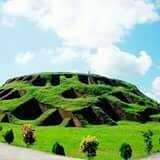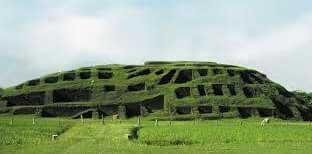Mahasthangarh Bangladesh,bogra.
 Mahasthangarh is one of the oldest ancient monuments in Bangladesh. Previously it was Pundravardhana or Pundranagar. At one time Mahasthangarh was the capital of Bengal. It was announced as the cultural capital of SAARC in 2016. There are many signs of Maurya, Gupta, Pala, and Sena empire found here. Its position in Shibganj upazila of Bogra district. Mahasthan average lies on the west bank of the Karatoya, about 13 km north of Bogra city.
Mahasthangarh is one of the oldest ancient monuments in Bangladesh. Previously it was Pundravardhana or Pundranagar. At one time Mahasthangarh was the capital of Bengal. It was announced as the cultural capital of SAARC in 2016. There are many signs of Maurya, Gupta, Pala, and Sena empire found here. Its position in Shibganj upazila of Bogra district. Mahasthan average lies on the west bank of the Karatoya, about 13 km north of Bogra city.
History:
This average was unprotected when Laksman Sen (1082-1125), the last ruler of the Sena dynasty, was king of Gaur. The King of Mahasthan was a tube whose conflict was with his brother Neel. At this time, a cursed Brahmin from at the place called Srikrityra in Dakshina, India, is here to atone for the sin. Because he was cursed for the sake of motherhood by a child or an ax. Later, he ended the dispute between these two brothers and became the King. This Brahmin's name was Rama. In history, he is known as Parshuram. It is said that Parashuram is a warrior with more spiritual power than Hazrat Shah Sultan Mahmud Balkhi (R :). (1205-1202) Parasuram was defeated and killed in the war.
Tourist places:
Mahi Sawar Mazar Sharif:
There is a historical mazar Sharif on the west side of the Mahasthangarh Bus Stand. The shrine of ancient ancient shrine was developed on the center of Pirzada Hazrat Shah Sultan Mahmud Balkhi (R :). He is said to have come on the back of the fish and he came to the varera land. So he is called Mahi Sawar. From a conventional story, it is known that a Muslim named Hazrat Mir Borhan lived here. King Parasuram ordered his sacrifice for sacrificing cattle by giving vows to the son and Mahi Sawarra arrived on the back of the fish to help him.
Kalidah Sea:
In the western part of the average, the historic Kalidah Sea and the residence of Padmadevi. The historical average of the Kalidah Sea is surrounded by an earthen pot. Rarendi baths were held in the ancient Kalidah Sea every year in March of the Hindu religion. After the bath, the pilgrims organized the Gangapuja and Sankirtan programs at the sea level.
Zeitunk Coup:
On the west side of Shiladebari Ghat of Mahasthan Garh there is a big coupe named Zeitkund. It is said that after drinking the water of this coup, the injured soldiers of Parshuram would be cured. Although no historical foundation was found.
Shiladevir Ghat:
Located 200 meters east of Mahasthangarh in Bogra district, in the Karatoya river. The main location of this ghat is opposite the Vairagi Bhater of Mahasthangarh. According to the local story, Shiladevi was the daughter or sister of Parasurama, the last Hindu king of Mahasthangarh. After the defeat of King Parshuram by the Muslim saint Shah Sultan Balakhi Mahiswar, Shiladevi sacrificed himself in the water of the Karatoya river. From then onwards, local Hindus used to visit this place every year in Shukla Dashami of Jai Shatra every year and Paush-Narayani for 12 years. Many people in the country and outside of the country come to the bank of the river to take part in this snooze. According to another report, the place was once used to keep the stones imported and stacked on the way, because its name is "Shila Island", and whose distortions are probably "Shiladevi" And "Shiladevir Ghat"
Museum:
Due to Mahasthan excavation, statues of gods and goddesses of Maurya, Gupta, Pala and Sen are found in the museum in the north. Besides the Mahasthan average, archaeological remains of more places are preserved here.
Bihula Basar house:
There is a Buddhist pillar that is believed to have been built by Emperor Ashok, about 2km southwest of Mahasthangarh bus stand. The height of the pillar is about 45 feet. In front of the pillar there is a 24-bath bath with a typical pond. It is known as Behula Basar house.
Govinda Vita:
Gobinda Vita is situated right in front of the Mahasthangarh Museum. Govinda Bhita is a excavated archaeological site. The word Govinda Vita means Govinda (Hindu deity) and Vishnu's house. But no evidence of Vaisnavism was found here. Yet the site is locally known as Govinda Vita.
Vaasu Vihar:
Bhasu Bihar is one of the earliest ancient monuments in Bangladesh. It is situated in the village of Bhasu Vihir of Bihar Union, 6 km west of Mahasthangarh, in Shibganj upazila of Bogra district. Locals know it as the step of the president. It is believed that it is a ruins of Sangharam. As a result of excavation, various valuable archaeological objects including bronze Buddhism, terracotta plaques have been discovered. The ruins of a large number of Buddhist buildings spread in the village of Bihar about 8 km west of Mahasthan. In 1879, Sir Alexander Cunningham, Hiuen Tsang described the ruins of ancient buildings built on the bank of the river along the banks of the river and identified it as the historic Vasu Bihar. In the tenth century Buddhist Vihara is one of the smallest among the other. The largest is located on the north side and the small south.
The artwork on the outer wall of this monastery was very nice. Seeing this wall with curved brick cornice, the makers of the artistic designs are found. There was no central temple in Bihar too.
The current name stands in the name of Mahasthangarh. Mahasthangarh is considered archaeological and historically important for various reasons. Mahasthangarh attracts tourists and archaeologists around the world as one of the oldest archaeological sites in South Asia. 
bogura are nice deistic its a really nice travel place in our bangladesh
Nice post. I love this place